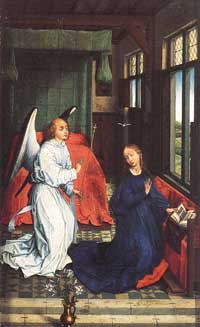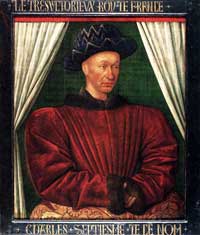Medieval Painters
The Medieval painters of the early Christian art were limited by prejudice against the study of the anatomy and nature, and their works are reflecting a certain indifference to physical beauty. They were also constrained by the forms of Byzantine painting tradition. The first efforts of independence are dating from the 11th and 12th centuries, but they did not go too far until the Gothic period.

Rogier van der Weyden
Announciation
Koninklijk Museum voor
Schone Kunsten, Antwerp
In the beginning, the artists of the Middle Ages expressed their talent through the art of the magnificent stained glass pictures of the cathdrals windows. The Gothic architecture offered them almost the entire wall surface, taking the place of the earlier paintings of the North, and they really reached perfection.
Overshadowed by the art of the stained glass windows, Medieval figure painting made little progress. There was limited patronage available, and in England, France or Spain this type of art was left to inferior artists. These factors contributed to its slower development. The works were generally confined to altarpieces and panel picture.
Medieval Flemish Painters
In the Low Countries, painting started to gain importance in the second half of the 14th Century. Not long after, the art history will record the first masterpieces of the Flemish painting: the works of the brothers Hubert and Jan van Eyck. Their most important work is the altarpiece of St. Bavo in Ghent with their powerful vision of "The Adoration of the Lamb".
Hubert and Jan van Eyck were masters of perspective, of treatment of light and shade, and they intensively studied the nature. Their compositions reached technical perfection. Their works and those of their followers belong to what was called "The Northern Renaissance", a movement independent from the Italian revival. Still relying on strong Medieval forms instead of classical inspiration, but responding to the ideals of the Italian movement, the artists of this period are seen as belonging both to the Late Gothic and Early Renaissance.
Among the early Medieval Flemish painters, Rogier van der Weyden and Hans Memling were the successors of the Van Eycks in the same century. Rogier van der Weyden has much of van Eyck's power, but is inferior in finish and in drawing. He is, however, an excellent representative of the average quality of Northern Gothic painting.
The works of Memling are almost as delicate as those of the van Eycks, but he did not leave compositions of large dimensions and of such a powerful execution as that of the "Adoration of the Lamb." His most famous works are the reliquary chest of St. Ursula in Bruges, and an altarpiece in Danzig (today's Gdansk) representing "The Last Judgment."
Medieval German Painters
Medieval painting flourished in Germany. Cologne, which was one of the great commercial centers of the later Middle Ages, was also home of the famous painting school bearing its name. Probably the works belonging to the School of Cologne cannot be compared with those of the Flemish artists. However, its greatest master, Stephan Lochner, executed the most beautiful painting of the Northern Gothic art next to the great work of the van Eycks. This is the "Adoration of the Magi," with flanking panels for the stories of St. Ursula and St. Gereon, in the choir of Cologne Cathedral. The Southern Germany also gave great Gothic artists, the best being Martin Schongauer and Michael Wolgemut.
Medieval French Artists

Jean Fouquet
Portrait of Charles VII of France
Musée du Louvre, Paris
France was the leader in miniature painting. In the 13th Century, a new style began to develop, inspired by the art of the sculptors and stained glass painters. This is suggested by the striking analogy between the figures of the Psalter of Saint Louis and the statues of the saints carved by contemporary sculptors. The illuminators did not rest content with the conventional design of the glass painter. In the Psalter of Saint Louis, the figures are life-like, with a dainty vivacity. The illumination artists gradually become masters of the suggestion of life, with their eyes wide open to nature.
There were of course painters working also in tempera on wooden panels, but they were actually practising the art of illumination on a larger scale, amplifying the compositions of the miniaturists.
Following the English invasion, the painting in France will evolve only in few provinces. Many artists from the Low Countries were attracted especially by the Court of the Dukes of Burgundy, but they also travelled further South, to Provence and Italy.
In Provence, Avignon, with its Papal Palace decorated with Italian frescoes, was already a known centre of arts. Among the artists passing through Avignon was Enguerrand Charonton, creator of the first masterpieces in the distinct French style, different from both the Italian and the Flemish styles.
At Aix, King René's Court attracted numerous artists, among them Nicolas Froment, an excellent portraitist, and a follower of the naturalism encountered in Netherlands.
Medieval French painting continued to flourish as an art full of delicate originality, and Tours, Bourges and Moulins became important schools, parts of what it is known as the School of the Loire. A distinguished example of this originality is Jean Fouquet, whose work owes little to the Netherlands art.
Medieval Italian Painters
The history of Italian painting is essentially a history of wall painting. The conditions of its perfection and greatness were created by the particular architectural character of the Italian basilicas, and their generous wall surfaces.
The greatest early painters of Italy were Duccio di Buoninsegna, Giovanni Cimabue and Giotto di Bondone, with Cimabue being the first innovator, as he applied his own independent modifications of style on the old Byzantine methods.
The 14th century Italian painting at large is fairly illustrated by Giotto's frescoes. No artist surpassed him in technical proficiency, solemnity, seriousness, religious feeling, and original power.
Giotto is the precursor of the Renaissance. Duccio, also an expert in design, determined the two movements of art within the Sienese School: the progressive movement which was headed by the brothers Pietro and Ambrogio Lorenzetti, and the more conservative one, headed by Simone Martini.
Soon, the painting of the Lorenzetti dominated the Sienese school, and there was little room left for Simone's ideals. However, some of the Italian artists who followed him are of high importance, the closest imitator being Lippo Memmi. Other followers were Barna, Francisco Traini, and Lippo di Vanni.
It may seem strange, but Simone's style found a fertile soil especially beyond Italy. It is mainly through the Martini's Sienese art that the French painters of the Middle Ages gave up their late Gothic extravagances. Simone's influence upon Franco-Flemish painting which was rising to independent consciousness, may be illustrated by Broederlam's Dijon altarpiece. And, among the Medieval painters of Avignon, Simone's influence created a school which in turn sent its influence to Spain.
